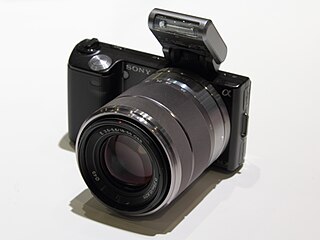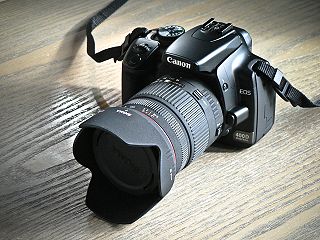
The Pentax K-mount, sometimes referred to as the "PK-mount", is a bayonet lens mount standard for mounting interchangeable photographic lenses to 35 mm single-lens reflex (SLR) cameras. It was created by Pentax in 1975, and has since been used by all Pentax 35 mm and digital SLRs and also the MILC Pentax K-01. A number of other manufacturers have also produced many K-mount lenses and K-mount cameras.

Originally produced as Konica Minolta AF Zoom DT 18-200mm f/3.5-6.3 (D) by Konica Minolta in 2005, and currently produced by Sony, the Sony α DT 18-200mm f/3.5-6.3 (SAL-18200) is compatible with cameras using the Minolta A-mount and Sony A-mount lens mounts. The DT designation means this lens is designed to be used with a camera with an APS-C size sensor. When the 1.5× crop factor is considered, the lens has an effective equivalent 27–300mm focal length. The lens is derived from the Tamron AF 18-200mm f/3.5-6.3 XR Di II LD Aspherical [IF] (models A14M/A14S).

The Canon EF-S 18–200mm lens is a superzoom lens, manufactured by Canon. It is the higher end kit lens for the Canon EOS 60D digital camera, and supplants the previous EF-S 17–85mm, in Canon's product line-up, losing 1mm off the wide end, and offering a roughly 2.5x longer telephoto end.

The Sony NEX-5 is a digital camera launched on 11 May 2010. It is a mirrorless interchangeable lens camera with the body size of a larger model fairly compact point-and-shoot camera with a larger sensor size (APS-C) comparable to that of some digital single-lens reflex cameras. Its major competitors in the market are the cameras based on the micro 4/3 standard created by Panasonic and Olympus, and a few low end Canon, Nikon, and even Sony α DSLRs. The NEX-5 shoots 14.2 megapixel stills and has a 7 frame/s continuous shotmode. It has the capability to shoot 1920×1080i at 60 frame/s in AVCHD or 1440×1080p at 30 frame/s in MPEG4. The NEX-5 was replaced by the 16 megapixel NEX-5N in August 2011.

The Pentax K-3 II is a flagship APS-C DSLR camera announced by Ricoh on April 22, 2015.
The Tamron 18-270mm F/3.5-6.3 Di II VC PZD is a superzoom lens for APS-C DSLR cameras, announced by Tamron on December 9, 2010. The Sony/Minolta A mount version is simply called Tamron 18-270mm F/3.5-6.3 Di II PZD as it lacks image stabilisation.
The Tamron SP 150-600mm F/5-6.3 Di VC USD is a super telezoom lens for DSLR cameras, announced by Tamron on November 7, 2013. The Sony A mount version is called Tamron SP 150-600mm F/5-6.3 Di USD as it lacks image stabilisation.
The Tamron AF 18-200mm F/3.5-6.3 XR Di II LD Aspherical [IF] Macro is a superzoom lens by Tamron, initially announced in 2005. A year later, Tamron announced the Tamron AF 18-250mm f/3.5-6.3 Di II LD Aspherical [IF] Macro with a slightly larger zoom range. However, in 2008, the 18-200 model was re-released with a built-in motor for Nikon bodies lacking a motor in the body - at that time the Nikon D40, D40x and D60.
The Tamron SP 70-200mm F/2.8 Di VC USD is an interchangeable telezoom lens with constant, large aperture. It is available in Nikon, Canon and Sony mounts and was announced by Tamron on September 13, 2012.

The Sony FE 24-240mm F3.5-6.3 OSS is a variable maximum aperture full-frame (FE) superzoom lens for the Sony E-mount, announced by Sony on March 4, 2015.

The Sony Zeiss Vario-Tessar T* FE 16-35mm F4 ZA OSS is a constant maximum aperture wide-angle full-frame (FE) zoom lens for the Sony E-mount, announced by Sony on September 15, 2014.

The Sony E 18-105mm F4 OSS is a fixed maximum aperture zoom lens for the Sony E-mount, released by Sony on August 27, 2013.

The Sony Zeiss Vario-Tessar T* E 16-70mm F4 ZA OSS is a constant maximum aperture zoom lens for the Sony E-mount, announced by Sony on August 27, 2013.

The Sony E 18-200mm F3.5-6.3 OSS is a variable maximum aperture superzoom lens for the Sony E-mount, released by Sony in 2010.
The Sony FE 70-300mm F4.5-5.6 G OSS is a variable maximum aperture full-frame telephoto zoom lens for the Sony E-mount, announced by Sony in 2016. Though designed for Sony's full frame E-mount cameras, the lens can be used on Sony's APS-C E-mount camera bodies.
The Sony FE 16-35mm F2.8 GM is a premium constant maximum aperture wide-angle full-frame (FE) zoom lens for the Sony E-mount, announced by Sony on May 17, 2017. The lens is scheduled for release on August 31, 2017.
The Sony E 18-200mm F3.5-6.3 OSS LE is a variable maximum aperture superzoom lens for the Sony E-mount, released by Sony on May 17, 2012. The lens was designed to better accommodate users of Sony's E-mount mirrorless cameras in weight and size.













